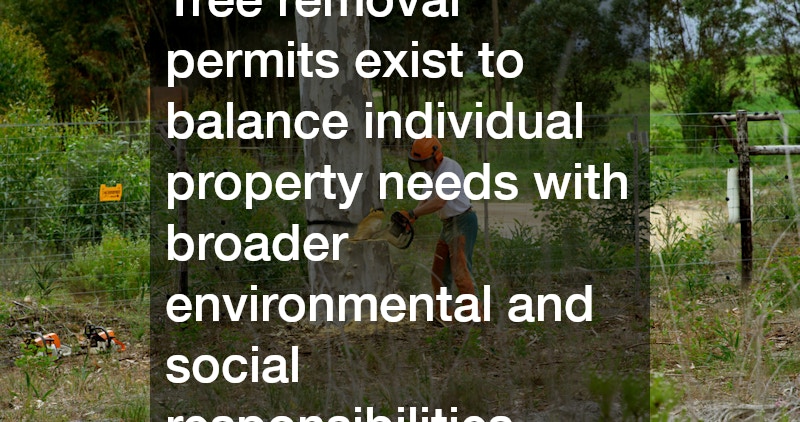Tree removal is often necessary to ensure safety, protect property or prepare for development. However, in Australia, cutting down a tree without proper authorisation can result in fines and legal complications.
Understanding when you need a permit, how to obtain one and the considerations involved are essential for homeowners, developers and landscapers alike. This guide offers an in-depth look at tree removal permits to help you navigate the regulations with confidence and avoid unnecessary setbacks.
Why Tree Removal Requires a Permit
Australia places strong emphasis on environmental conservation and the protection of native vegetation. Local councils and state governments have introduced stringent rules to prevent indiscriminate tree clearing. These regulations aim to maintain biodiversity, reduce the urban heat island effect, preserve the aesthetic value of green spaces and protect wildlife habitats. As such, a tree removal permit is required in many situations, particularly when dealing with mature or native trees, even if they are on private property.
Permits help assess whether the removal is justified and ensure that alternate options, such as pruning or relocation, are considered first. They also enable councils to enforce replanting schemes or environmental offsets if necessary. Each local government area has its own criteria for issuing permits, making it important to check the specific guidelines for your region.
When Is a Tree Removal Permit Required?
While the exact rules differ between councils, permits are commonly required in several situations. If a tree is above a certain height or trunk diameter, it will typically fall under protection regulations. For example, in many municipalities, any tree over five metres tall or with a trunk diameter of 300 millimetres measured at chest height may not be removed without permission.
The tree’s species also plays a crucial role. Native or heritage-listed trees are more likely to be protected under local planning schemes or vegetation overlays. Additionally, if the tree is located in a conservation area, bushfire-prone zone or near a waterway, special rules may apply. In some cases, dead, dying or dangerous trees may be exempt from permit requirements, but this usually needs to be confirmed by a qualified arborist and documented with evidence.
How to Apply for a Tree Removal Permit
Applying for a tree removal permit typically involves submitting a formal application to your local council. This process generally requires details such as the location of the tree, reasons for removal and supporting documentation. Most councils will also request a report from a qualified arborist that outlines the tree’s condition and risk factors. This report should include photos, health assessments and alternative options considered.
Once submitted, the council may inspect the site or request further information. The assessment period can take a few days to several weeks, depending on the complexity of the case. If the application is denied, you can usually appeal the decision or request a reassessment with additional evidence.
Risks of Unauthorised Tree Removal
Attempting tree removal without a permit can result in significant penalties. Fines vary between councils but can reach tens of thousands of dollars, especially for protected species or repeated violations. In some instances, legal action may be pursued and the property owner could be held liable for environmental damage.
Beyond the legal ramifications, unauthorised removal can also impact property values and neighbourhood aesthetics. Trees provide shade, improve air quality and contribute to the local ecosystem. Removing them without due process can lead to community backlash or damage your reputation with local authorities and neighbours. Therefore, it’s always best to proceed with caution and seek approval when in doubt.
Factors Councils Consider Before Granting Approval
When assessing tree removal applications, councils take multiple factors into account. These include the tree’s health, risk to people or property, impact on infrastructure such as foundations or plumbing and its ecological significance. If a tree poses an immediate danger—such as being at risk of falling during storms—permits may be expedited.
Development plans also influence approval. If a tree is located where a building extension or driveway is planned, it may be deemed permissible for removal, provided suitable offsets are included. However, councils may still encourage redesigning plans to preserve significant trees where possible. Urban planning frameworks increasingly prioritise green infrastructure, meaning tree retention often plays a role in approval decisions for new developments.
Working with Professionals
Engaging an experienced arborist or tree care professional is often necessary during the application process. These specialists can assess the tree’s condition, determine risk levels and provide detailed reports that support your case. Moreover, if the permit is granted, professional removal ensures the job is performed safely and in line with local regulations.
Arborists can also help identify less invasive alternatives, such as structural pruning, bracing or cabling to improve tree stability. These options may allow you to keep the tree while eliminating risks. Consulting with a professional early in the process can save time and prevent costly mistakes.
Responsible Tree Management Starts with Permits
Tree removal permits exist to balance individual property needs with broader environmental and social responsibilities. By securing the proper approvals, you contribute to sustainable urban development while avoiding legal complications. Informed, respectful decisions about tree removal not only protect the environment but also reflect a commitment to community wellbeing.
.

